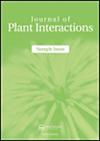Gall-inducing Psylloidea (Insecta: Hemiptera) – plant interactions
IF 3.3
3区 生物学
Q2 PLANT SCIENCES
引用次数: 2
Abstract
ABSTRACT The Psylloidea, >4000 named species known today, are plant-feeding, sap-sucking insects sleeved under the Sternorrhyncha. Most species of Psylloidea are confined to the tropics. They occur as gall-inducing, free-living, and lerp-forming taxa. Lifecycles and generations of gall-inducing Psylloidea vary in temperate and tropical worlds. The Triozidae, Aphalaridae, and Calophyidae include several taxa that induce galls of diverse morphologies, from simple pits and leaf-margin rolls to complex pouches and of two-tier structures. The feeding mechanism and nutritional physiology of the gall-inducing taxa of the Psylloidea differ from those of the free-living and lerp-forming species. A majority of the gall-inducing Psylloidea are associated with the dicotyledons and a small number with the monocotyledons. The gall-inducing Psylloidea are specific to certain plants. Their host specificity is regulated by specific lipids and sterols. The gall-inducing Psylloidea show conservative behavior in terms of geographical distribution. Although the life histories of several gall-inducing Psylloidea are known today, aspects explaining their association with host plants are little known. Details of nutritional physiology of gall-inducing Psylloidea are less known presently compared with that of the free-living species. A better understanding of the association and level of relationship between gall-inducing Psylloidea and their host plants is necessary.生瘿木科(昆虫纲:半翅目)-植物间的相互作用
木科是一种以植物为食、吸吮汁液的昆虫,目前已知有近4000种。木科的大多数种类都局限于热带地区。它们以诱导胆囊、自由生活和形成息肉的分类群出现。在温带和热带世界,引起胆病的木科植物的生命周期和世代各不相同。三足虫科、棘足虫科和刺足虫科包括几种不同形态的瘿,从简单的坑状和叶缘卷状到复杂的袋状和双层结构。木科产胆分类群的摄食机制和营养生理与自由生活和产胆分类群不同。大部分生瘿木总科与双子叶有关,少数与单子叶有关。产生胆管的木科是某些植物所特有的。它们的宿主特异性是由特定的脂质和固醇调节的。产胆的木科在地理分布上表现出保守性。虽然几种诱导胆的木科植物的生活史今天是已知的,但解释它们与寄主植物的关系的方面却鲜为人知。与自由生活的种相比,目前对诱导胆的木科植物的营养生理细节知之甚少。更好地了解诱导胆病的木科植物与其寄主植物之间的关系及其水平是必要的。
本文章由计算机程序翻译,如有差异,请以英文原文为准。
求助全文
约1分钟内获得全文
求助全文
来源期刊

Journal of Plant Interactions
PLANT SCIENCES-
CiteScore
5.30
自引率
6.20%
发文量
69
审稿时长
>12 weeks
期刊介绍:
Journal of Plant Interactions aims to represent a common platform for those scientists interested in publishing and reading research articles in the field of plant interactions and will cover most plant interactions with the surrounding environment.
 求助内容:
求助内容: 应助结果提醒方式:
应助结果提醒方式:


